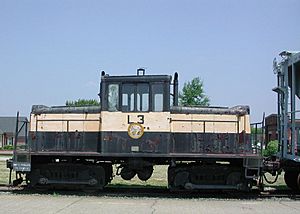Delta Valley and Southern 50 facts for kids
Quick facts for kids DV&S 50 |
|
 |
|
| A sister locomotive | |
| Power type | Diesel Electric |
|---|---|
| References: | |
| Builder | General Electric |
| Serial number | 32129 |
| Model | 45 ton |
| Build date | May 1954 |
| AAR wheel arr. | B-B |
| UIC classification | B'B' |
| Gauge | 4 ft 8 1⁄2 in (1,435 mm) |
| Minimum curve | 50 ft (15 m) |
| Weight on drivers | 45 short tons (41 t) |
| Locomotive weight | 45 short tons (41 t) |
| Fuel type | Diesel |
| Engine RPM range | 1800 |
| Displacement | 672 cubic inches (11 L) |
| Traction motors | one on each truck side rod drive to second axle |
| Cylinders | 6 in each of two engines |
| Cylinder size | 4+7⁄8 in × 6 in (124 mm × 152 mm) |
| Power output | 2 x 150 hp (112 kW) |
| Tractive effort | 27,000 lbf (120 kN) |
| Locomotive brakes | Air |
| Train brakes | Air |
| Last run | unknown |
| Current owner | unknown |
| Disposition | unknown |
|
Delta Valley & Southern Railway Locomotive #50
|
|
| Area | less than one acre |
| Built | 1954 |
| Architect | General Electric |
| NRHP reference No. | 06001263 |
| Added to NRHP | January 24, 2007 |
The Delta Valley and Southern 50 is a special kind of train engine. It's a standard gauge diesel-electric locomotive. This means it uses diesel engines to make electricity, which then powers electric motors to move the train. It was built by General Electric in May 1954. This engine, known as GE #32129, replaced an older steam locomotive on the Delta Valley and Southern Railway. Even though it's called a "45-ton" engine, its actual weight might be a bit different.
Contents
How DV&S 50 Works
This locomotive gets its power from two Cummins HBI-600 diesel engines. Each engine has six cylinders. These diesel engines don't directly power the wheels. Instead, each one drives a generator. The generators then create electricity.
This electricity powers a single electric traction motor on each of the locomotive's two trucks (the wheel sets under the train). A "side rod" connects the first axle to the second axle on each truck. This helps both axles get power from the motor.
The Delta Valley & Southern Railway
The Delta Valley and Southern Railway, often called "DVS", was a short railroad line. In 1996, it operated only two miles of track. This track ran from a place called Delpro to Elkins, Arkansas. The railway carried about 600 train cars each year.
Originally, the DVS line was much longer. It stretched over 18.1 miles from Delpro to Tyronza. However, in 1947, the track was shortened. For most of its history, the DVS was part of the larger St. Louis – San Francisco Railway, also known as the Frisco.
History of DV&S 50
From 1954 onwards, DV&S 50 was the only locomotive used on this railway. It worked there until it was sold to a person named Edwin Kessler.
Later, the Burlington Northern Santa Fe (BNSF) was supposed to deliver the locomotive to Oklahoma City. However, there was a disagreement about the delivery. BNSF tried to sell the locomotive at an auction in Oklahoma City on May 6, 2009. The bidding ended on May 26, but no one bought it. The last time anyone saw the locomotive running was in Omaha, Nebraska, on November 5, 2009. Today, no one knows where this historic locomotive is.
In 2007, the locomotive was recognized as an important historical item. It was added to the National Register of Historic Places. It is listed as Delta Valley & Southern Railway Locomotive #50.
Different Types of GE Locomotives
General Electric (GE) made many different types of small diesel-electric locomotives. These were used by industries and smaller railroads. Here are a few examples:
GE 44-ton Switcher
- These locomotives were designed to weigh less than 90,000 pounds.
- This was important because, at the time, it meant only one engineer was needed to operate them. A second crew member, called a fireman, was not required.
- They had two Caterpillar diesel engines.
- They had two four-wheel trucks and four traction motors.
- These engines had 400 horsepower and could go up to 35 miles per hour.
- They needed a minimum curve radius of 125 feet. This means they needed a wider turn to go around corners.
- They were often used on smaller branch lines of bigger railroads.
GE 45-ton Switcher
- These locomotives, like the DV&S 50, were made for light industrial use.
- They had two Cummins diesel engines.
- They also had two four-wheel trucks, but only one traction motor per truck.
- They had 300 horsepower and a top speed of 20 miles per hour.
- They could handle very tight curves, with a minimum radius of just 50 feet.
- This design made them perfect for industrial areas with sharp turns and limited space.
GE 50-ton Locomotive
- These locomotives had a two-axle (four-wheel) setup. Each of the two axles had its own traction motor.
- They used the same main engines as the 45-ton locomotives.
- However, they had a much lower and narrower body. This design allowed them to operate in very tight places, like steel mills.
- Their top speed was 15 miles per hour.
- The extra weight in these locomotives was added as "ballast" to make them heavier.

